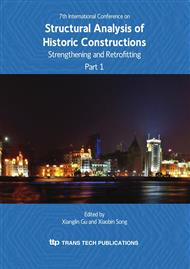p.211
p.217
p.223
p.229
p.235
p.241
p.247
p.253
p.259
Historic Buildings: Long Term Stability Evaluation Using Wireless Sensor Networks
Abstract:
An automatic diagnostic monitoring system can guarantee the safety and integrity of a historic building. In this paper, we describe the long term application of a wireless sensor network (WSN) for permanent health monitoring in the Torre Aquila, a historic tower in Trento, Italy. The system consists of accelerometers, thermometers and fiber optic sensors (FOS) with customized wireless modules and dedicated software designed for wireless communication. The whole system was completed and started operation in September 2008, and data from the various sensor nodes are collected continuously, save during periods of system maintenance and update. Based on the first 1.5 years of operation in assessing the stability of the tower, the WSN is seen to be an effective tool. Modal analysis indicates that the tower has two independent structural parts. A comparison between the acquired long term deformation measurements and simulated numerical results shows good agreement. Monitoring of ambient vibration suggests that such vibration is not now a source of concern for the stability of the tower.
Info:
Periodical:
Pages:
235-240
Citation:
Online since:
October 2010
Authors:
Price:
Сopyright:
© 2010 Trans Tech Publications Ltd. All Rights Reserved
Share:
Citation:


